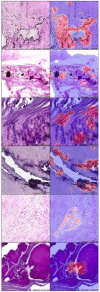Deep Learning Assisted Diagnosis of Onychomycosis on Whole-Slide Images
- PMID: 36135637
- PMCID: PMC9504700
- DOI: 10.3390/jof8090912
Deep Learning Assisted Diagnosis of Onychomycosis on Whole-Slide Images
Abstract
Background: Onychomycosis numbers among the most common fungal infections in humans affecting finger- or toenails. Histology remains a frequently applied screening technique to diagnose onychomycosis. Screening slides for fungal elements can be time-consuming for pathologists, and sensitivity in cases with low amounts of fungi remains a concern. Convolutional neural networks (CNNs) have revolutionized image classification in recent years. The goal of our project was to evaluate if a U-NET-based segmentation approach as a subcategory of CNNs can be applied to detect fungal elements on digitized histologic sections of human nail specimens and to compare it with the performance of 11 board-certified dermatopathologists.
Methods: In total, 664 corresponding H&E- and PAS-stained histologic whole-slide images (WSIs) of human nail plates from four different laboratories were digitized. Histologic structures were manually annotated. A U-NET image segmentation model was trained for binary segmentation on the dataset generated by annotated slides.
Results: The U-NET algorithm detected 90.5% of WSIs with fungi, demonstrating a comparable sensitivity with that of the 11 board-certified dermatopathologists (sensitivity of 89.2%).
Conclusions: Our results demonstrate that machine-learning-based algorithms applied to real-world clinical cases can produce comparable sensitivities to human pathologists. Our established U-NET may be used as a supportive diagnostic tool to preselect possible slides with fungal elements. Slides where fungal elements are indicated by our U-NET should be reevaluated by the pathologist to confirm or refute the diagnosis of onychomycosis.
Keywords: U-NET; artificial intelligence; deep learning; dermatology; onychomycosis.
Conflict of interest statement
The authors declare no conflict of interest.
Figures





References
LinkOut - more resources
Full Text Sources

